■ The patient is placed in a modified lithotomy position using Yellofin stirrups with the heels firmly planted in the stirrups.
■ Pressure-bearing areas in the calf and lateral legs are padded to prevent DVT and lateral peroneal nerve injury.
■ The patient’s toes, knee, and contralateral shoulder are aligned.
■ The thighs are placed parallel to the ground to prevent conflict with the surgeon’s arms.
■ The patient’s buttocks are placed at the edge of the table to allow for smoother introduction of the end-to-end anastomosis (EEA) stapler at time of reconstruction.
■ Both arms are tucked at the sides, with padding added to protect against nerve injuries.
■ The patient is taped to the table across the chest over towels to avoid slipping.
■ All laparoscopic elements (CO2 line, camera, light cord) exit through the right upper side. All energy device cords exit through the upper left side. This allows for a clutter-free working space for the operative team.
Team Positioning and Draping
■ The patient is prepped with chlorhexidine and draped to facilitate easy access to the perineum.
■ The surgeon stands at the patient’s right lower side, with the assistant to his or her left side and the scrub nurse to his or her right side (FIG 2).

■ Two monitors are placed in front of the team at eye level on the patient’s left side.
TECHNIQUES
PORT PLACEMENT
■ Insert the GelPort through a 5- to 6-cm Pfannenstiel incision. This incision will be also used for specimen extraction. It results in better cosmesis, lowers the incidence of wound infections and hernias, and allows for more working space between the hand and the instruments.
■ Ports: Insert a 5-mm working port in the right upper quadrant (RUQ), a 12-mm working port in the right lower quadrant, and a 5-mm camera port above the umbilicus. These three ports are triangulated, with the camera port at the apex of the triangle. This setup avoids conflict between instruments and camera and prevents disorientation (avoids “working on a mirror”) (FIG 3).

OPERATIVE STEPS
■ Our HAL sigmoidectomy operation is highly standardized and consists of nine steps:
■ Transection of the inferior mesenteric vein (IMV)
■ Transection of the IMA
■ Medial to lateral dissection of the descending mesocolon
■ Sigmoid colon mobilization off the pelvic inlet
■ Descending colon mobilization
■ Mobilization of the splenic flexure
■ Intracorporeal distal transection
■ Extracorporeal proximal transection
■ Intracorporeal anastomosis
Step 1. Transection of the Inferior Mesenteric Vein
■ This is the critical “point of entry” in this operation. We favor it over starting at the IMA level due to the IMV’s constancy in location, the ease of its visualization by the ligament of Treitz, and the absence of structures that can be harmed around it (no iliac vessels or left ureter nearby). This will be the only time during the operation when a virgin tissue plane is entered. Every step will set up the following ones, opening the tissue planes sequentially.
■ The patient is placed on a steep Trendelenburg position with the left side up. Using the right hand, move the small bowel into the RUQ and the transverse colon and omentum into the upper abdomen. If necessary, place a laparotomy pad to hold the bowel out of the field of view, especially in obese patients. This pad can also be used to dry up the field and to clean the scope tip intracorporeally. Make sure the circulating nurse notes the laparotomy pad in the abdomen on the white board.
■ Identify the critical anatomy: IMV, ligament of Treitz, and left colic artery (FIG 4).
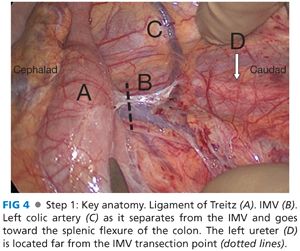
■ If there are attachments between the duodenum/root of mesentery and mesocolon, transect them with laparoscopic scissors. This will allow for adequate exposure of midline structures.
■ Pick up the IMV with the right hand. Incise the peritoneum under the IMV and dissect in front of Gerota’s fascia with endoscopic scissors, starting at the level of the ligament of Treitz. Proceed with the dissection caudally towards the IMA. The assistant provides upward countertraction with a grasper.
■ Transect the IMV (FIG 5) cephalad of left colic artery, which moves away from the IMV and toward the splenic flexure of the colon, with the 5-mm energy device, thus preserving intact the left-sided marginal arterial arcade, and preserving the blood supply to the anastomosis.
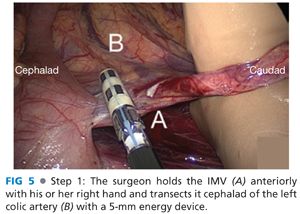
Step 2. Transection of the Inferior Mesenteric Artery
■ Identify the critical anatomy: the “letter T” formed between the IMA and its left colic and superior SHA terminal branches (FIG 6).
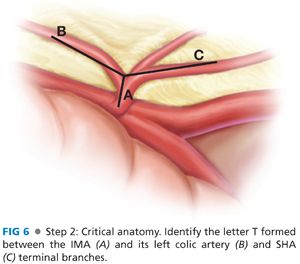
■ Using the hand, the aorta is identified and tracked down to the level of its bifurcation. The IMA will originate 1 to 2 cm proximal to this level.
■ Holding the SHA up with the right hand, dissect the plane along the palpable groove between the SHA and the left iliac artery using laparoscopic scissors. After scoring the peritoneum under the SHA, use a 5-mm energy device to dissect (by gently pushing downward toward the retroperitoneum) along the avascular plane located between the meso-descending colon, anteriorly, and the retroperitoneum, posteriorly. This avascular plane can be identified by the transition between the two distinctive fat planes.
■ Preserve the sympathetic nerve trunk intact in the retroperitoneum. Identify the left ureter, located in front of the left iliac artery and psoas muscle and medial to the gonadal vessels, before transecting any structure.
■ You can now visualize the dissected letter “T” (FIG 7). Dissect with your thumb and index finger around and behind the IMA and transect the IMA at its origin with a vascular load stapler (FIG 8, dotted line) or energy device. This ensures excellent lymph node harvest and great exposure for step 3.
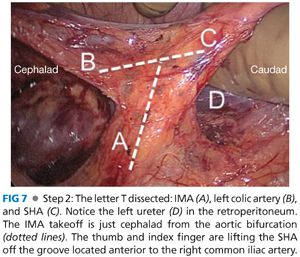
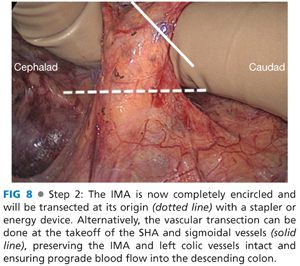
■ Alternatively, the vascular transection can be done at the takeoff of the SHA and sigmoidal vessels (FIG 8
Stay updated, free articles. Join our Telegram channel

Full access? Get Clinical Tree








